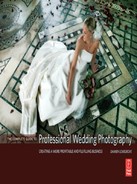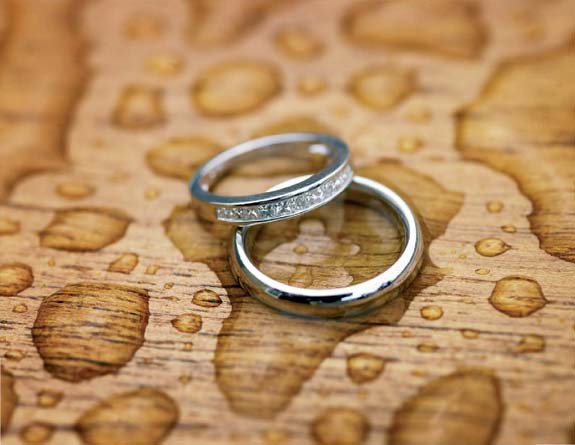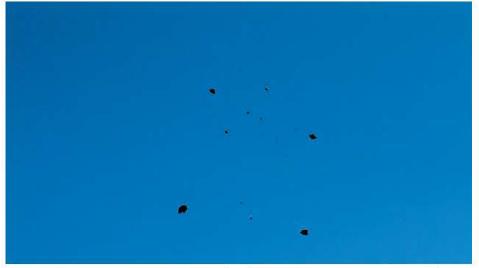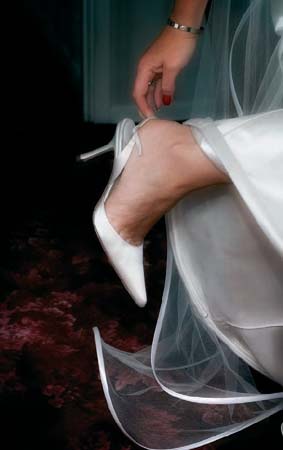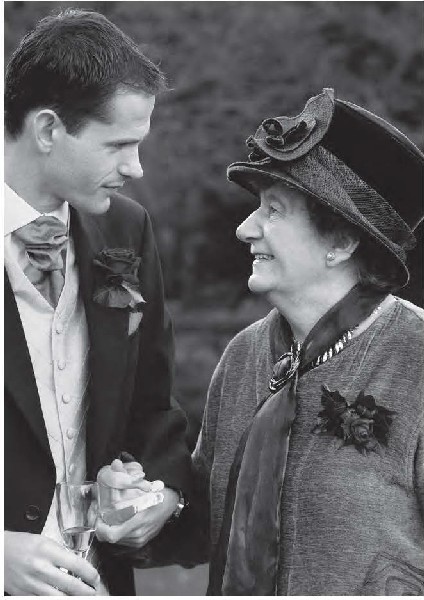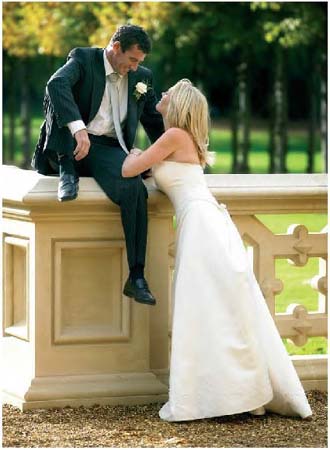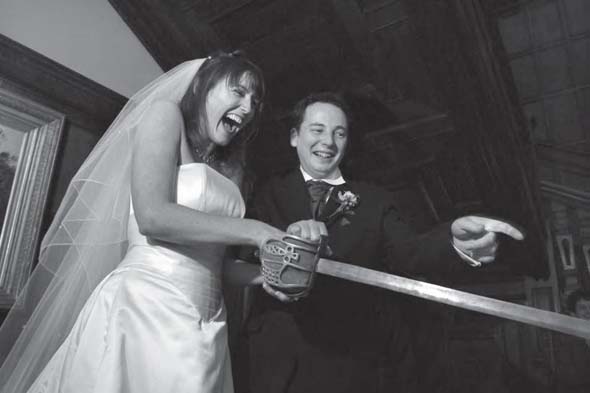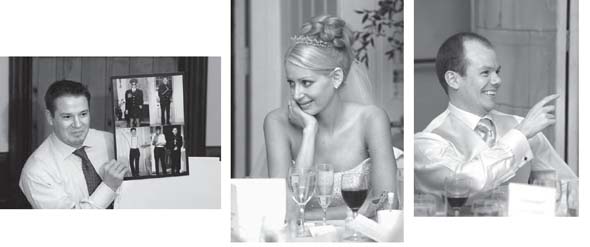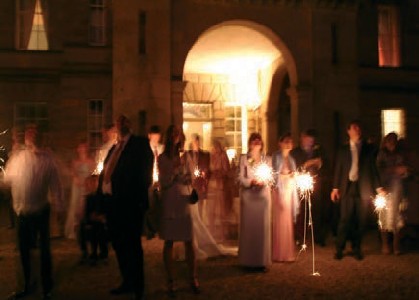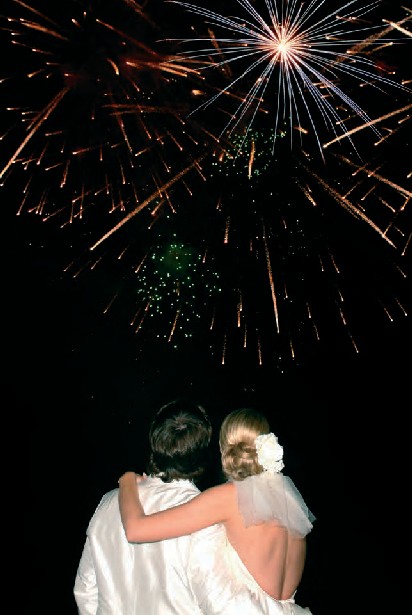Well this is it – the Big Day. For the bride and groom it is probably the most important day of their lives. So we don’t want to disappoint them. In fact we want much more than that – we want to make sure the pictures we deliver go far beyond their wildest expectations. How do we ensure this? By very careful planning, by hard work, by thinking on our feet, by drawing on our experience, and by building on the rapport we have already established with the couple during the pre- wedding shoot.
All set then? Here’s a blow by blow account of a typical Lovegrove wedding.
EARLY MORNING
What better way to start your day than with a good breakfast? While you’re at it, plan the rest of your day’s eating arrangements too. On the way to your first rendezvous you may need to buy sandwiches for later in the day. We always carry an insulated cool box with us in the car for such eventualities. It’s vital to keep up your energy levels for the whole day.
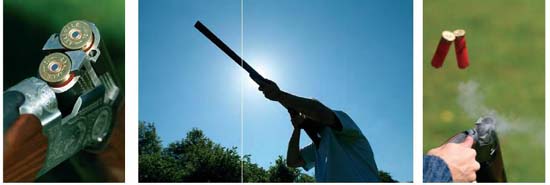
FIGS 2-5 Settings from ISO 100 f/4 at 1/SOOth for the gun detail to ISO 400 f/8 at 1/4000th for the shot clay in the sky.
Clay pigeon shooting can be illustrated in so many ways. I like to use a more abstract approach at times

Fig. 6 ISO 400 f/5.6 at 1/90th
This group picture of the swimmers was taken right at the end of the swimming session. I had to leave my Hasselblad on a heater for 20 minutes before I could get pictures without condensation on the lens or the sensor. There was a male bonding process that went on to get this picture. A ring of body contact unites the group.
Next, carefully check your camera kit and load it into the car. This is a personal ritual that needs to happen every time. So create a system and stick to it. Repeating a set routine is less likely to allow you to forget a vital bit of equipment. Once we get to the hotel car parking lot, I always take one random shot and play it back. This proves to me that the camera has fully charged batteries, and that the settings are sensible. It also gives me confidence in my equipment and my ability to use it.
Julie and I then go through the running order for the day so that we are clear who’s doing what, when, and where. (If we have a late start and the reception venue is nearby we might do a mini reconnaissance and have coffee there too. The reconnaissance will be to determine a good location for photographing the groups, establishing a rapport with the coordinator and checking that the catering time plan matches ours. It is not uncommon for the hotel to move the sit down time by half an hour to give them more time to clear a room after dinner for instance. Careful negotiation at this stage is vital.)
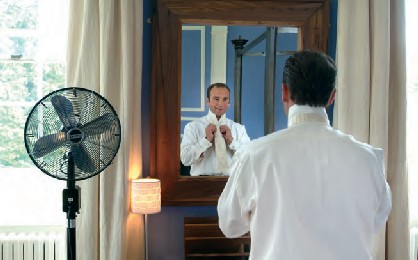
I have a habit of switching on table and wall lights in hotel bedrooms. The cool blue wall in the mirror balances the yellow glow from the lamp. The fan made a great prop so I moved it into the shot. The rim light on the groom’s right shoulder from another window out of shot provided just enough separation of the light tones on the right
Once our checks are completed, we set up the day’s venues on the satellite navigation system and head off to meet up with our respective parties. We always carry detailed maps as a backup. You never know when roadworks, an accident, or a police controlled incident may cause you to change your travel plans. Julie might drop me off at a golf club or at a hotel to meet up with the groom or I might drop her with the bride. These arrangements will have been planned for sometime. Once we have both arrived at our first meeting points and photography is underway, Julie and I often confirm all is well on the phone. Changes of plan or useful snippets of info gleaned are often relayed at this time. For instance, Julie might mention the bridesmaids are traveling in a black car rather than a horse and carriage and the oldest one will try and avoid the camera because she hates having her photograph taken. Armed with this info I will shoot candids with a long lens when the bridesmaids arrive at the church rather than shoot in close on the wide lens.
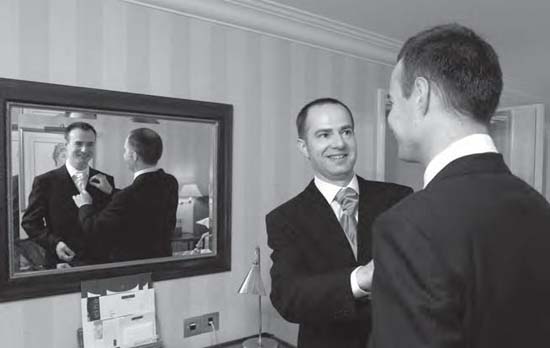
Another mirror shot lit with off-camera flash shows an interesting arrangement of viewpoints. I shot this from 6 inches below the groom’s eye line to add drama

Fig. 9 ISO 400 f/13.5 at 1/700th
Two men, two clouds, and a pebble beach. I chose a low viewpoint to include more of the sky and to strengthen the foreground stones. I also chose to use more depth of field than usual and broke my own rules by doing so
RELAXING WITH THE GUYS
Our objectives are clearly set for the first photography shoot of the day. When I meet up with the guys, my aim is to re-establish rapport with the groom and get to know the best man and the ushers and make sure they understand how I’m going to work. Only once I have something to photograph in front of me will I get the camera out. Every photographer’s style is different. I choose not to hide behind the camera or be constantly fiddling with it.
I will often encourage the guys to start the day on the golf course or the shooting ground. If they decide to play nine holes, I’ll arrange to meet them on the 6th green. This will give me three complete holes to get the shots I need. Bear in mind that while nine holes on most courses takes just under 2 hours, on the wedding day morning the adrenaline alone is likely to whiz the guys round in about an hour and a half. So be prepared and arrive a good 20 minutes to half an hour early at the club house. The 6th green is often quite a way from the club house so I’ll ask someone for a lift on a cart. I prefer to walk the three holes with the guys as it gives me a good opportunity to get to know them. I’m after just twelve or so shots from this part of the day.
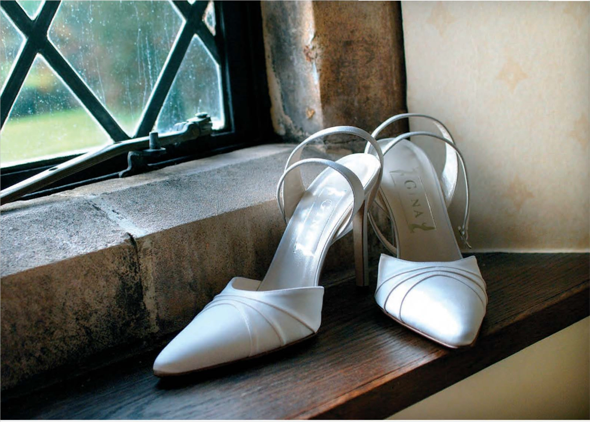
Fig. 1 0 ISO 800 f/4 at 1/125th
By including part of the old window in this picture of a bride’s shoes Julie is setting the scene. It’s the small details that say so much about a building
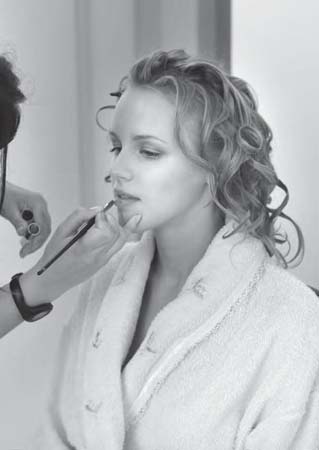
Wonderfully soft natural light gives this picture its charm. At light levels this low it is easy to resort to using flash. Resist the urge and better pictures often result
The shots I want are the same if I’m at a clay pigeon shoot, a golf course, or at a health spa. I take wide shots to tell the story and establish the scene, closeups to show the detail and add drama, tight action shots of each person, arty silhouettes or reflections, and finally a group shot of all participants. The camera then goes back in the bag and once the activity is over, we head off to the bar or next location. Do not over shoot. Have the end product in mind. Ask yourself, ‘How many pictures of the golf or the guys swimming will make the wedding album?’ Be realistic.
JULIE JOINS THE GIRLS
Meanwhile, Julie joins the bride 2 hours before she needs to leave for the ceremony. This gives her plenty of time to set up shots of the shoes, bouquet, veil, tiara, dress, and so on. Never forget that a small fortune has probably been spent on all the bridal accessories, so make sure you record them and handle everything with extreme care.

Fig. 12 ISO 200 f/4 at 1/360th
Fun moments like these are worth waiting for, but only once you have set the positions of the girls so you can shoot into the light
If the flowers are delivered during this time, Julie will capture the moment when the florist first shows the bouquet to the bride – this often helps create a great reaction shot. Providing that the bouquet hasn’t been delivered at the last minute (meaning time is tight) Julie will wait until the florist has left before taking the bouquet out of its box and photographing it. Although Julie takes the greatest of care with the bouquet, she doesn’t want the florist telling her that she can’t place it in a certain way in case the flowers get bruised or damaged.
With the shoes, once Julie has her ‘safe’ shot, she will often experiment with different angles and lighting situations to ring the changes – it’s not uncommon for more than one shot of the shoes to make the album. Other details to be photographed at this stage are bridesmaids’ shoes, dresses, bags, and so on. Julie usually moves all of the above to a suitable location, sets up the shot, and then returns everything once it’s been photographed. If all the bridesmaids’ shoes are the same, she always checks that each one knows which is theirs – if there is any possibility that one girl may end up wearing the wrong shoes, Julie will write their initials inside before moving them.

Fig. 14 ISO 400 f/4.8 at 1/60th
The best things come in threes. Julie shot into the light using a specula reflection off the shiny table to provide the drama. An increase in exposure compensation was needed to get this look in camera
Once all the accessories have been photographed, Julie will spend most of the remaining time building rapport with the bride, the bridesmaids and of course, the bride’s mother, while their hair and make up is being done. She may take one wide shot of the bride with her hair in rollers or very little makeup on, but often waits until hair and makeup is nearly finished before tucking herself in a corner of the room to photograph the bride head and shoulders. She’s not shooting loads of frames – just the important ones such as lipstick being applied, or blusher being brushed on. If the back of the hair looks fabulous, Julie makes sure she has a shot of this feature before it’s covered up with a veil. At this stage, depending on the background or available light, she may ask the make-up artist if she can finish off in a different place. It may only be a move of a couple of feet, but this can make all the difference to the photograph. This is also a great time to get some shots of the bridesmaids or the bride’s mother in the room with the bride – it tells the story of who was there with her when she was getting ready.

Fig. 15 ISO 400 f/4 at 1/280th
This tiara was placed on the piece of veil fabric Julie carries neatly folded in her camera bag. It becomes an instant studio background for still life pictures
BACK WITH THE GUYS
Meanwhile, back with the boys, I start to shoot my ‘getting ready’ pictures. While the groom is showering, I photograph the rings, his pocket watch, or anything else I can find that references the wedding. I look for cards or gifts from the bride, a set of speech cards or unique detail on his shirt or waistcoat. I used to have a dedicated macro lens but now I just use a +4 dioptre on my100 mm lens. I keep the camera steady using my monopod and shoot into the light where possible. I don’t shy away from high ISO, or slow shutter speed. These pictures rarely go bigger than postcard size in the album and I shoot as quickly and with as much efficiency as I can. A monopod allows me to shoot at three stops slower shutter speed and it keeps me relaxed because itcarries the weight of the camera while I compose my shots.
There’s a good reason for these shots. The more ‘guy details’ I can shoot, the more ‘bride details’ will make the album. Keeping the ‘his and hers’ sessions in balance makes for a better album and produces more print sales. Once the groom has a shirt and pants on, I concentrate on the camaraderie between the guys. I will start by arranging the area to be used for the pictures. This entails clearing away debris such as carrier bags and suit bags and opening the curtains if required. I like to see other light sources too, so I’ll put on bedside lights where possible.
If the best man and ushers are getting ready in other rooms, I arrange for them all to meet in the groom’s room before the cufflink and cravats stage. The fun generated by all the fiddling around, makes great pictures. Occasionally, I get shots of ironing, shoe polishing, and other male grooming. I usually try to get a sequence of the groom with the best man. It is also important to shoot the groom on his own: a good setup is to have him putting gel in his hair or straightening his tie in front of a mirror.

Fig. 17 ISO 320 f/4 at 1/140th
Details that include a key to the mood of the moment are more valuable than those that are inert. Including the bride’s mouth in this jewelry picture even though it is out of focus was the right thing to do
Intimacy between men is rarely shown on the wedding day, so I help it along by getting the men to do each other’s cravats or cufflinks. Ritualistic drinking of champagne, beer, or tea should also to be encouraged to create a feeling of team spirit and conviviality. I usually set this up as a group shot. A ‘semi-casual’ look – shirtsleeves or waistcoats – is ideal. I will take the same group outside the ceremony so I want this picture to be a bit different. Incidentally, I always leave the buttonholes until we arrive at the ceremony location: car seat belts can cause havoc with buttonholes and corsages.
It’s a good idea for wedding photographers to have the skills required to tie Windsor, half Windsor, and Four-in-Hand tie knots. Knowing how to make a cravat look good and the ability to pin various types of buttonholes without ruining the line of a suit is very useful too. You can find all this information on the internet for free. In my camera bag I carry a sewing kit, the sort usually found in hotel rooms, a multi-utility tool, and a box of matches. These items are often needed in the morning at one time or another.
It’s now time for the guys to get to the ceremony. I usually go through a quick checklist with the groom just before we pull away, to ensure we have everything: rings, orders of service, speeches, buttonholes, bottled water, money, and so on. The groom is usually both nervous and excited, so this can be a useful exercise often saving the day! This all goes toward the client experience and adds value to our service.

Fabulous hair, a beautiful bridesmaid, and wonderful light combined to great effect for this candid picture.
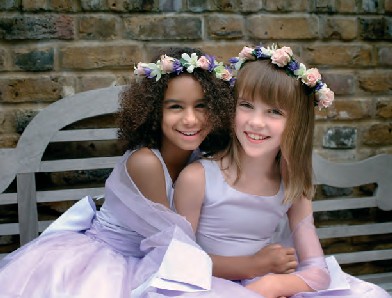
Fig. 19 ISO 320 f/4 at 1/660th
Here Julie had a bit of fun with the flower girls at the bride’s home while she waited for the cars to take them all to the church. The expressions on the girls’ faces reflect on the moment Julie had created
JULIE SHOOTS THE DRESS AND SPREADS CALM
Meanwhile, Julie is at the final bridal preparation stage. She will already have tidied away all bags, cases, boxes, discarded clothes and even made the bed if necessary. She will have decided exactly where she wants the bride to put her dress on, and moved furniture if necessary.

Fig. 20 ISO 200 f/4 at 1/180th
I chose to shoot this groom at ground level to make compositional use of the snaking path. This pose removed some of the formality that a standing picture might have had and it helped the groom before the ceremony

Fig. 21 ISO 400 f/4 at 1/250th
I like to get a picture of the groom and the best man arriving at the church. I was inside the church for this picture shooting out of the door on a 200 mm lens. I was lucky the focus didn’t decide to go through to the background
By now things may be starting to run late, in which case Julie’s job is to gently move the proceedings along as quickly as possible – helping wherever possible. This often involves helping the bride to put her dress on and do up the buttons or laces as the bridesmaids or Mum have disappeared to get ready themselves. Julie only needs a couple of shots to tell the story, so if the bride is getting stressed she’ll come to the rescue – that’s much more useful than standing there with camera in hand doing nothing!
Finally, it all comes together and the relative calm of the previous hour and a half has now become a flurry of activity.
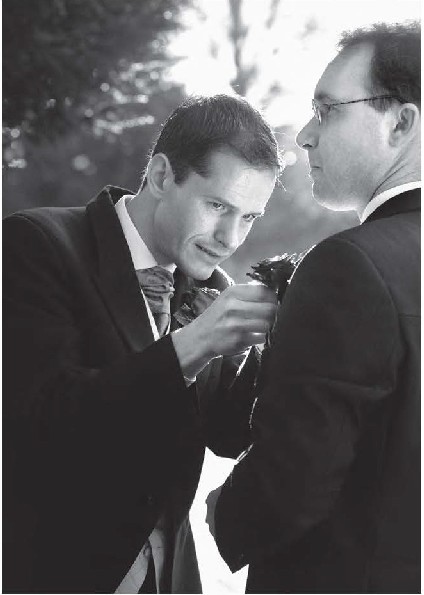
Figs 22 & 23 ISO 800 f/4 at 1/125th and 1/470th
This groom was kept busy before the ceremony and I chose to keep my framing tight to add impact to the composition.
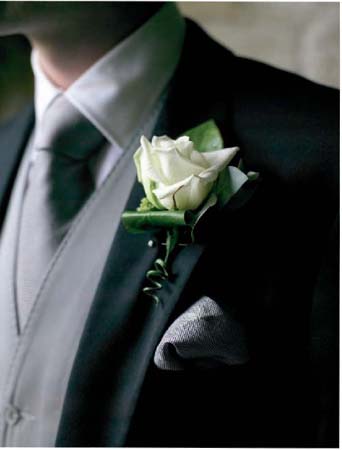
With tight framing like this pictures can have a broader appeal. The florist as well as the couple ordered this picture and it was used full page to illustrate an editorial feature in a UK wedding magazine.

Taken just before they left for the ceremony, this full length shot of a bride and her bridesmaid with their flowers was a must have for Julie. Pictures like this are easy to forget to shoot and are always wanted
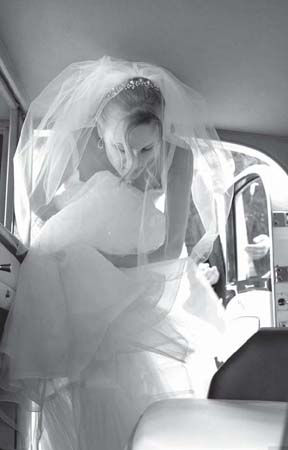
Predicting the action is vital to capture moments like this. Julie went round to the other side of the car and shot through the open door. Staying beside the bride would have been a big mistake
The aim is for everyone to be ready 15 minutes prior to leaving as this ensures there is time for the following shots:
-
Bride on her own, closeup and full length, arty shots, fun shots, and beauty shots
-
Bride with bridesmaids, closeup, and full length
-
Bride with siblings and family.
If things are running late however, Julie will never add to the stress by setting up shots. It’s more important to get the bride to the ceremony as quickly as possible – besides, if the bride is stressed, there is absolutely no point in taking photos of her as (a) she’ll look stressed in the photos and (b) she’ll remember the stress when she views the photo and won’t buy it anyway. All these pictures can be taken during the reception so it’s much better to be a savior than an irritation.
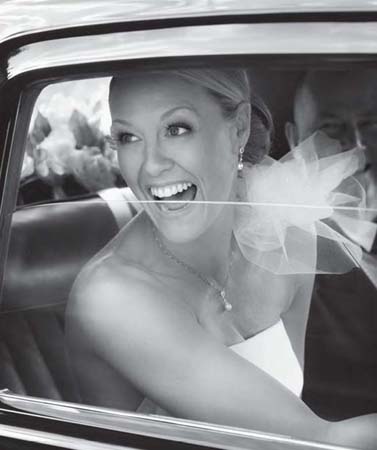
Fig. 27 ISO 200 f4.8 at 1/180th
Another great moment caught by Julie. It is often worth Julie hanging on until the last possible moment before she makes her way to the church safe in the knowledge I’m already there to capture the bride’s arrival
Sometimes we will have a super-efficient bride who is itching to get into her dress an hour before she needs to. Julie will dissuade her from doing this, because once she has the dress on, the bride will not want to sit down, eat, drink, or do anything for fear of creasing it, or spilling things on it. This is where experience is invaluable – Julie knows how long it is likely to take to get dressed and can guide the bride (not to mention her worried Mum) so that calmness rather than chaos reigns!
OUTSIDE THE CHURCH OR CEREMONY LOCATION
At the ceremony location, I have several shots to get before the main event including the putting on of buttonholes. I usually get the guys to stand in the church or venue porch. This gives top cover and open shaded light. A wide shot sets the scene and closeups of the action follow. I shoot the wide on my 35 mm lens and swap to the 100 mm for the rest. Once the buttonholes are on it’s time for a group picture before the ushers have to do their stuff. This group is quite formal. The guys may never look this good again!

Fig. 28 ISO 800 f/4 at 1/360th
A well seen picture taken by Julie in Chelsea, London as the bride drove past the film advert poster
Then come the long shots of the groom and best man and finally the groom on his own. I let the groom have a moment to himself as I go and find the priest, or officiator. My next role is to negotiate exactly where Julie can stand at the front and what coverage she can get: flash, or no flash, vows or not, and so on. Once the pleasantries are over and the deal struck, I’m off to photograph the flowers, candles, and other decorations. At the back of theroom I grab an usher for a picture with the orders of service. Ithen get an action shot of guests being greeted by the ushers.
With 5 minutes to go I get a picture of the groom at the front of the room waiting. I might quiz him about the girls being late and this prompts a look at the watch, which always raises a laugh when my shutter goes in unison! I wish him a good ceremony and leave him in the capable hands of the best man. I’ll say Hi to the groom’s parents and family before heading down the aisle and waiting for the bridesmaids. I keep my eyes peeled for interesting pictures. Gargoyles, the church cat, pageboys, and the ushers all make good picture opportunities. If there is a clock tower, I’ll get a big wide shot a few moments before the ceremony starts. I have to keep my wits about me at this point because I am where the action is and I have to be ready for anything. I keep my camera bag close at hand near the main entrance and venture off with my 100 mm on the camera. Having no zoom and using a fairly tight lens is risky but the pictures are worth it. At the BBC, the saying was ‘If in doubt, zoom out.’ (Meaning, if you lose focus, or the action is all around you, play it safe and use the wide-angle lens.) Playing it safe doesn’t produce the great shots though, so I’m happy to take a few risks. If I’m having a confidence crisis I’ll put the 35 mm lens on and keep back so as not to distort the perspective. Marko, our picture editor, can always crop in tighter later.
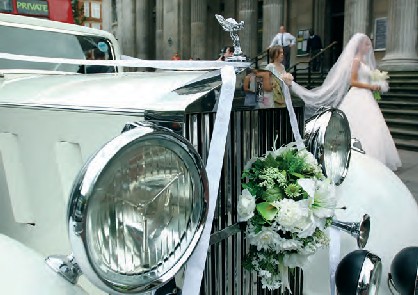
Fig. 29 ISO 800 f/4 at 1/2000th
I used a shallow depth of field to great effect here with my 17 mm lens. Split focus can be achieved with wide lenses if the point of focus is very close to the camera
Now I await the bridesmaids. A few shots of them together looking at the camera and at each other and then I get ready to photograph the bride arriving. Julie is often just ahead of the bride. I’ll quickly relay the instructions from the officiator and let her know what I’ve negotiated with regard to her coverage. I’ll photograph the bride arriving in a reportage style, not stopping the action, just going with the flow. At the entrance I’ll get a chance to take a few formal portraits of the bride and her father or the person taking her down the aisle. Next, I swap to the35 mm lens to capture the bridesmaids fluffing the dress. While the ‘meet and greet’ is going on with the ceremony official and the bride, I slip past and take my place to the side at the back of the room. I attach my flash with Stofen via the coiled transistor- transistor logic (TTL) lead for the start of the procession.

Fig. 30 ISO 400 f/4 at 1/125th
I used a splash of flash and a stop of exposure increase to get life into this picture. A photograph taken in a heavily backlit place like this is at risk of having a heavy, near silhouette quality
THE CEREMONY
Julie has a clear view down the aisle with her 200 mm lens. And I get a shot with the wide from close hand. By now you will understand that we have a system. The key to our success is sticking to a procedure so that each of us knows exactly where we should be and what pictures we should get at each stage of the day. This still leaves room for creativity and during the ceremony is one place I like to exercise it.
Julie is static and to the right at the front with her Nikon on a Manfrotto monopod. Switching between lenses she gets the whole story in close detail favoring the bride. I shoot from the center of the aisle at the back. Once I have my wide shots I look for other shots of interest. I use minimal depth of field to record the flowers on the pew ends or I set up a still life of the order of service or cones of confetti. I have about 20 minutes to be creative. A glance at the order of service will tell me when the readings are. I’ll need to get pictures of the readings as Julie is not in the ideal place to cover these. I’ll also get a shot of ‘… I therefore proclaim that they are husband and wife.’

It’s not often I consider taking a figure in the landscape picture like this of the bride and her father on their way into the ceremony. The sheer scale and grandeur of the Royal Naval College in Greenwich deserved such a picture. The wonderful reflected light on the risers of the steps leads the eye into the picture
After that, I’ll pop outside and get shots of the cars or perhaps a horse and carriage. Arty exterior shots of the church are also on my list. Back inside, my next shot is during the signing of the register. I’ll have my wide lens on with my flash to record any wide shots of the family or impromptu groups during the register signing. Julie gets the pictures of the signing itself. Once we have acknowledged to each other that all is well and ‘in the can’ I’ll get a shot of the organist or soloist before heading to the back to get ready for the procession down the aisle. I pack my camera bag neatly, collapse my monopod and rest it on top. I have my Hasselblad with its Phase One P25 digital back in my right hand with the 35 mm lens at f/4 and I have my Metz flash in my left hand set to TTL, attached to the camera by the Metz TTL lead. I switch the camera to manual focus and set the focus to 10 feet. The ISO is set to 400 and the shutter speed to1/45th. I casually walk up the aisle to meet the bride and groom coming down toward me. When we are 10 feet apart, I back off, maintaining that distance while shooting at decisive moments to capture the action. Once a safe shot has been caught, I will go for a high-angle image by holding the camera above my head. A quick glance up at the screen tells me if I need to adjustmy framing.

Fig. 32 ISO 800 f/5.7 at 1/30th
It is easy to see where I stand to take photographs during a ceremony in this picture of the painted hall in Greenwich. I am always behind the last row of guests and ready to capture the moments using either a wide or very tight lens
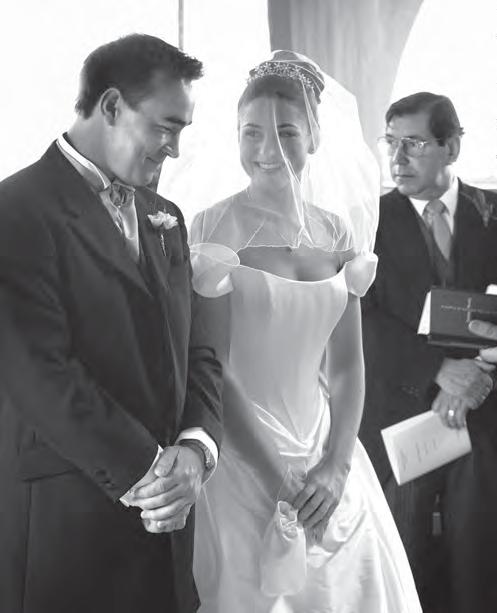
Fig. 33 ISO 1600 f/4 at 1/45th
Julie stands at the front of the ceremony room and to the right so that she is facing the bride when the couple look at each other. In this picture, Julie used plus two stops of increased exposure to counteract the intense highlights from the windows behind the bride

It’s okay to cheat. I took this picture of the organist while he was rehearsing some 30 minutes before the start of the ceremony. Getting this picture during the ceremony would have risked disturbing him and upsetting his performance

FIGS 35 & 36 ISO 200 f/4 at 1/5OOth
I went under the tree to use the foliage to help frame this chapel. I then went and shot the candles through the window from the outside

Fig. 37 ISO 400 f/4 at 1/125th
A long lens and shooting into the light made this a strong picture. The diagonal composition and shallow depth of field added interest.
OUTSIDE AGAIN
Julie in the meantime has made her way out of the ceremony and carried my bag with her. She has now set her camera to the settings required for the daylight outside. I step aside as the couple leave the church or ceremony room. Meanwhile, Julie is in place to get a clean picture as they exit the building. The next 5 minutes are very important. I take 30 seconds or so to set my camera to cope with the new conditions then I hoist it high above my head on my monopod for a self-timed exposure. This top shot is very popular and sells well. Julie steps back out of the shot, and uses her 200 mm to pick up candid emotions from relatives and friends of the couple. Between us we tell the story well. I shoot the wide shots and the intimate moments while Julie shoots the closeups and the people shots. We work quietly and efficiently knowing what is expected of each of us.
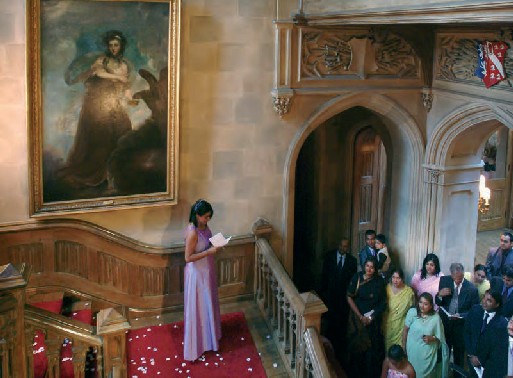
I used the balustrade of the staircase to rest my monopod against for this low light picture of a bridesmaid giving a reading. I wanted to include the background painting of the woman in my composition because it has harmony with the action. The low angle viewpoint the painter has used in his/her work gives the woman depicted strength and purpose
The confetti happens next. Julie and I often shoot this from opposite angles. I’m happy to include Julie in my pictures as we are part of the story too. Julie rarely gets me in the shots because she is on tighter lenses at f/4. After the confetti, either Julie or I go to get the car while the other one of us shoots the bride and groom preparing to leave.
Our car is poised right behind the bridal car with the engine running by the time the couple leave. I’ll jump in and we are off. A great shot en-route is always a pleasant bonus if it happens. This is a good time for me to have a sandwich, while Julie drives. A wedding day shoot is like an action movie and we are halfway through. By this time we should have about 500 frames on our Compact Flash cards between us. Later, these will get edited down to about 175 to show the client and they will have about 90 or so in their album up to the end of the ceremony. An ideal ratio is about one in every four frames shot to make the book.

Julie had to increase the ISO to capture this couple singing. An exposure increase was also necessary

Some ceremonies seem to present challenging lighting conditions. With good lenses that resist unsightly flair a stop of exposure increase was all that was needed to make this picture
THE RECEPTION
At the reception our aim is to take the bride and groom off for a photo shoot virtually straightaway. While their guests arrive in dribs and drabs, park up, and powder their noses, we are working flat out setting up sequences and taking portraits. We will work as a team, Julie will set up shots for me, and I will set up shots for her. I have my 35 mm lens on the camera and Julie has her 70–200 mm. When we create ‘as directed’ actionwe both shoot the same moments with about 45 degrees between us. These shots taken at the same time, from different angles, and with different lenses work very well indeed. We both shoot at f4 throughout and the sequence comes together seamlessly in the final album. We will work wherever the light and venue takes us. A 15-minute journey around the grounds or staterooms at this stage yields a strong set of pictures.
When the bride and groom rejoin the gathering, Julie and I start to explore our opportunities. We look around the back of the kitchens, beyond the boundaries and really come up with a plan for a second shoot. Gardener’s sheds, old greenhouses, barn with tractors, stable yards, woodland, and formal gardens all make great opportunities for something a bit different. With the plan set we rejoin the main party. I shoot big wide shots and casual groups mingling while Julie shoots the details, canapés, champagne, and so on.

41 & 42 ISO 800 f/4 at 1/110th for both pictures
These two pictures were taken in very quick succession using a long lens. If I had used a wide lens to capture the whole scene some of the magic would have been lost: the look of love in the groom’s eyes or the elegance of the bride’s hands
Once we have the story planned, we will take the bride and groom off on our little adventure. The next 10 minutes are spent ‘going with the flow’ creating striking couple shots and individual portraits. We will go to places the couple themselves haven’t seen and we will be alone, just the four of us – no video, no bridesmaids, or hangers on. This is our time and our creative session.
Having had a load of fun, we return to the party. Julie enlists the help of the ushers and gives each of them a printed list of the group shots required. I set up for the groups shooting into the light, and avoiding the sky in the frame. If we are inside because of bad weather I will set up our Broncolor Mobil battery-powered flash with a brolly on a tall Lowell stand. Staying self- powered is a good thing; it avoids trailing cables, working with unknown power supplies and the risks they bring.

43 & 44 ISO 800 f/4 at 1/60th and ISO 800 f/4 at 1/125th
Julie and I both took these pictures on tight lenses at 90 degrees apart. The light was excellent and the moment was wonderful

This moment summed up the day of fun and celebration. The subject movement adds life to the picture.

The best moments often happen in dark places. I was on the limit of my Fujifilm S2 and my 200 mm lens to capture this great look

Julie’s role at the front of the ceremony is to capture the moments as they happen. A great sense of timing is necessary to get the picture and I find I often miss the moment where Julie succeeds. It is primarily for this reason I leave the main role at the ceremony to her

I held the camera way over my head to take this picture. It gives the couple a superstar look. I’m always on the lookout for new angles and ways of shooting things

I take a straight shot too for safety but I make sure to choose my moment. More recently a shot like this will be full of guests’ camera
It is the ushers’ role to gather the people required for the groups. The lists they have were printed by us a week ago or so from the details sent through by the couple. We give them a 10- minutes warning saying something like, “In 10 minutes time at a quarter past four, can we please have all the people listed here, over there at the far end of the lawn.” This gives the ushers time to get Uncle Harry out of the bar and Aunt Ethel wheeled into place. By utilizing the ushers in this way we are not the ones demanding the attention of the guests.
We work through the groups quickly and efficiently. I always invite other family and guests to take their pictures first once I have set up the group. I then ask everyone in the group for their attention. If I catch eyes wandering off I politely ask that no one else takes pictures at that time because of distractions. This is rarely needed if they have already taken their shots. Once I have everyone’s attention I create a fun moment and take the picture. I’ll take a couple of other frames too while looking around the group working with individuals to bring out the best in them. My camera is always on the monopod and I might stray to f/5.6. Marko will combine a few of the frames to make a group without compromise.
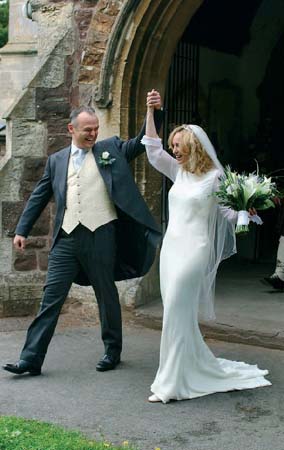
After the signing of the register Julie slips out of the church and is ready to capture the exit of the bride and groom. Julie will shoot from one side allowing me to get a shot from inside without us seeing each other
Teenagers need a different sort of encouragement to their parents or young children, so I create several moments aimed at different parts of the group. This is just part of the service that keeps our product that bit special. I will only arrange a group once all the required people are present, this way they will not be getting bored with me and they can carry on chatting. Julie shoots from about 45 degrees to me, to pick up singles of important family members and guests using her 200 mm lens. Once she has good frames of the right people, Julie will go and photograph the table settings, the cake, and the room where the reception meal will be served.

The sunlight rimming the couple adds to the picture of this wonderful moment

Julie, in pink is in this picture. Occasionally, we shoot 180 degrees apart for a confetti sequence. We are part of the day and it makes sense to be part of the album too
I will put my 210 mm lens on my camera and shoot couples having fun, bridesmaids and pageboys playing, and other key elements that create a visual record of the day. Soon it’s time for a glass of champagne. I love champagne, and a few salmon canapés go down well too! At this point we’ll devote a few moments to spot checking the running order, ticking off the shots we’ve done, checking the time and generally gathering our thoughts together. We like to keep an overview of what’s going on and how we have done. Julie might say ‘get a good picture of the bride’s mother now that she’s relaxed. She looks petrified in all the shots I took of her earlier.’ This is just the time to do it.
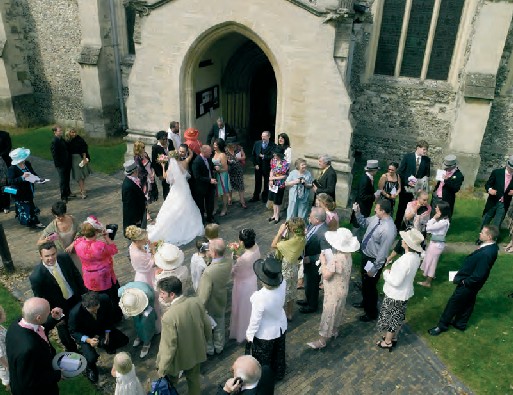
This shot was taken on my Hasselblad at the top of my monopod using the self- timer set to 10 seconds to trigger the shutter. It takes a bit of madness to hoist $40,000 of camera, lens, and digital back above your head on a top-heavy pole. Disclaimer – ‘Don’t try this at home.

A delighted bride, a loving groom, a top hat on the parcel shelf, and great light come together in harmony

Celebrity weddings can attract a bit of a crowd so be prepared. I took this picture with the camera held above my head
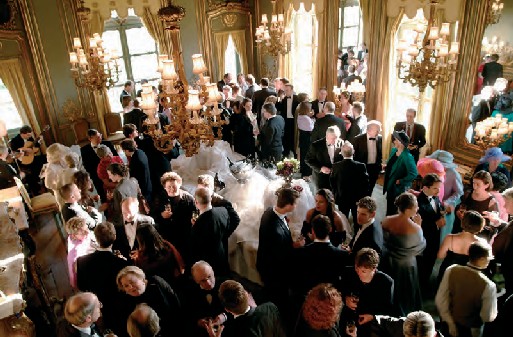
Here is another top shot taken with my camera on the monopod resting high up against the wall in the corner of the room at Cliveden House
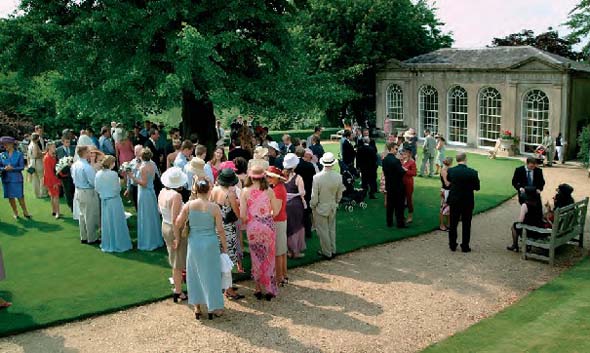
Establishing wide shots like this one taken by the summerhouse of Sherbourne Castle are always favorites for our clients. The color and ambience tell the story so well
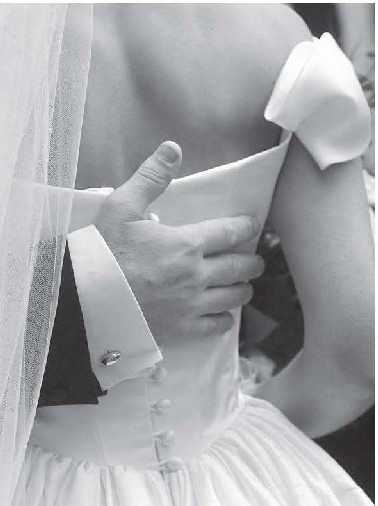
62 & 63 ISO 400 f/4at 1250th and1j550th
Julie captured both the tiara picture and the hand on the back of the dress picture candidly using a long lens.Staged closeups rarely look natural

64 & 65 ISO 400 f/4 at 1/1450th and 1/650th
I shot the wide and Julie captured the closeup of almost identical moments. Both pictures made the album. My exposure was a stop less than Julie’s because I had to hold the detail in the dress.

66 & 67 ISO 400 f/4 at 1/SOOth
I asked the groom to hop up on the pillar and I shot these two frames into the light.
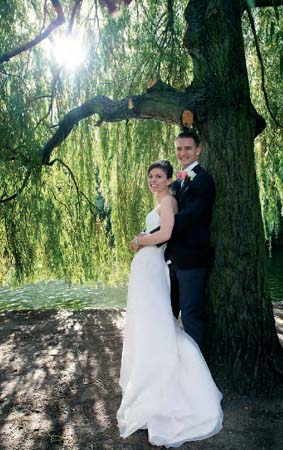
A bit of spot flare from the sun works in this picture in St James park in London.
The next big event is often the big group of all attendees. I try to get some height for this shot and when possible, I liaise with the venue to get a key to an upstairs room overlooking the lawn. I aim to shoot this picture just 5 minutes before the guests are called in to sit down for dinner. That way, once I have taken the picture I can hand over to the best man or wedding coordinator to announce dinner. The whole party are in one place and this system works well.
Both Julie and I shoot the entrance of the bride and groom. We shoot from different angles and keep out of each other’s way. I like to take an overhead shot. It adds a sense of royalty or movie star quality to the picture. We then place our camera equipment near the table where we are seated and join the other guests for dinner. We can relax for an hour or so knowing we have every shot we need up to that point.

It’s not possible to spot the sun in this picture as it is completely blown out. Plus two stops exposure compensation was needed for this picture taken in Florence, Italy
After the starters and before the main course, Julie might nip out and set up the laptop in a backroom away from prying eyes. Here she will start the download process. There will probably be three or four Compact Flash cards to download by this stage. Capture One pro is the software we use on our MacBook Pro. We create the session on an external bus-powered 120Gb Firewire external hard drive. This will allow us to hot swap the files with other computers back at the studio without the need for duplication. The images are also left on the flash cards at this stage.
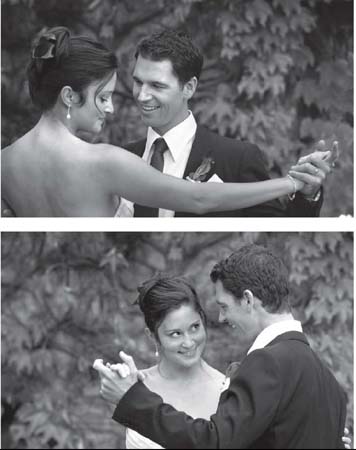
70 & 71 ISO 800 f/4 at 1/250th
We found some shade for this shot and asked the couple to practice their first dance. The look of love on their faces is fabulous.
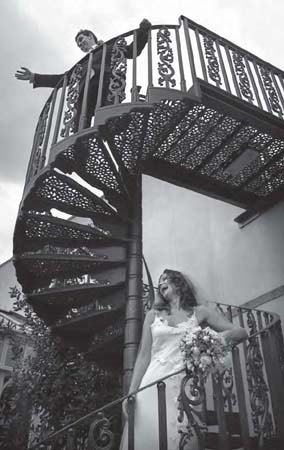
Spiral stairs are always a good place to take pictures even if they are just a fire escape as in this picture
If the food looks great, is well presented, with elegance and design, I capture it. I take pictures of my own plate using my Metz flash held off-camera to create low angle interesting sidelight. With the lens at f/4 and the camera set to manual, I get a shot suitable for a recipe book. Once the image is right, I’ll eat the food with the feeling I’ve earned it!
Our next big task is to photograph the speeches. As you might expect, we have a system for this. Just before the speeches commence, we tidy the top table. We place bottles of water down beside the table and remove the table name or number if it obscures anyone. Floral arrangements may also have to go temporarily. I shoot using TTL flash off-camera, ISO 400 f/4 at 1/45th second and a 35 mm lens. I am like a jack in the box. I sit on the floor in front of the top table, and pop up to take pictures at opportune moments. Julie is always toward the back of the room using TTL flash off-camera and settings of ISO 800 f/4 at 1/60th second with a 70 to 200 mm lens. The important fact is we try very hard indeed not to block the vision of any guests. During one of the speeches, I will nip round behind the speaker to get an over the shoulder wide shot view of the room. This sets the scene. Julie will duck out of the way for this shot. I also take top shots with the camera held above my head during toasts or applause. The sequence of speech pictures in the album can often run to 20 or so prints. With over 10% of the album shot at this time we take this section very seriously indeed.

There is always a minor risk element that kicks in to your train of thought when you go away from the action to pursue a better vantage point. I had to get through several rooms and onto the balcony in time to catch this frame of the couple on the stairs. I kept the camera upright and chose to place the bride and groom in the bottom third of the frame. This avoided diverging verticals and showed the scale of the entrance hall at Wedderburn Castle in Scotland

Placement of the bride and groom in the bottom left of the frame together with the distant Babington house in sunlight made this picture an ideal wedding magazine front cover. This is the kind of publicity that venues and photographers thrive on. Remember, there is often a wider use for your images than the wedding album. Couples and their families often enjoy the added publicity magazine coverage brings them.
After the speeches comes the cutting of the wedding cake. Not all weddings are the same of course and some don’t have a cake to cut, but if they do it’s usually my task to cover the moment. I stick with my 35 mm lens and get in quite close. I often have to direct the couple a bit to get them behind the cake to one side. I ask the groom to place his hand on the knife first so he doesn’t crush the bride’s hand. I count them down and conduct a cheer from the gathering of onlooking guests. I get a couple of frames at the right moment and keep down out of everyone else’s shots.
Capture One builds previews as it goes, so while I’m covering the cake cutting, Julie has the opportunity of checking the shots from earlier in the day. This is especially useful as she might notice that in the one shot we thought we had of the bride’s brother, he is half blinking. This kind of thing is normal and it will be my job to whisk him of for another portrait later on. If this moment is handled well, it can really add credibility to our professionalism. I often make the re-shoots seem like they are just our way of giving personal attention to important guests. We will go into the reception area, outside, or perhaps into an adjacent room to take these pick up shots. Occasionally we get spotted and a few impromptu groups happen. Sometimes the children have made new friends and I photograph them on the stairs or in a ‘group hug.’

This is a common site at today’s weddings. Even the children want to be involved with taking the pictures, and so they should. The inexpensive digital SLR has rekindled the hobby of photography at a higher level among amateurs. I took this picture into the light and I managed to keep out of her picture
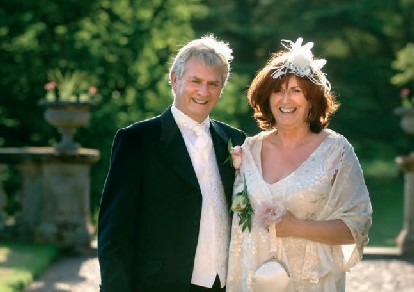
I like to take pictures of parents, and other key friends. Julie will often invite couples to be photographed by me and within a few minutes we can have been a very prolific team. I exclude sky and I shoot into the light, always at f4

77 & 78 ISO 200 f/4 at 1/725th
It is easy to be attracted to take pictures of a pretty girl in a red dress but I am always aware of the value of a balanced coverage. A lot of fun can be had taking a picture of long-established family friends like these three ladies. I was shooting a series of family group pictures into the light and I glanced round to capture this picture of the bride’s mum’s friends
Meanwhile, I’m keeping my eye on the light outside waiting for the right time to take an external dusk picture. Even if the weather is bad and it’s raining, a wide shot of the venue at dusk is always a winning picture. I’ll get the tripod from the car and use up to 30 seconds exposure to record the last fading light in the sky contrasting with the warm glow of the interior lights. I find the calmness outside and the fresh air reinvigorating. Ten minutes too late and the shot will be gone. The timing is critical.
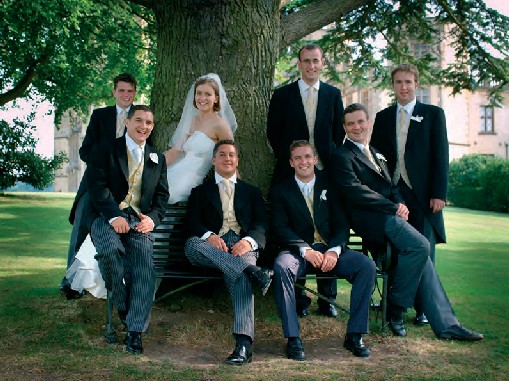
The shade from this cedar tree was a very welcome location for this informal group shot on a hot summers day. I’m glad I took the decision to place the bride at the back of the group and the groom on the left as it makes a far more interesting layout than the more obvious symmetrical option

I love taking the opportunity to play at recreating movie scenes. I staged this picture to be taken on a long lens

Another group shot taken into the sun. This time, I placed the guests in their subgroups and made the bride’s father the star
Once it is dark and the band are ready it’s time for the first dance. Julie and I work together on this using different techniques to record the event. I love ‘flash and burn,’ that’s a technique taught to me by the photographer Andy Earl. It involves combining a long exposure of perhaps 1/4 second with a splash of flash and a healthy amount of camera movement or shake. Julie prefers to use a long exposure without flash. I will get a few ‘safe’ shots captured too, just in case the couple want a clean look to the dancing pictures.

When it’s too dark to shoot outside or the weather is bad I set up the groups inside using a 1200 W battery flash and an umbrella. I took the decision to keep the aperture closed to f/7 to have enough depth of field for the group. I then decided I wanted to use a maximum of ISO 200 to keep the image quality as high as I could get. This left me with an exposure of 1/4 second to record the wall lights. I relied on the short duration of my Broncolor flash to freeze any subject movement and I used a tripod to steady my Hasselblad
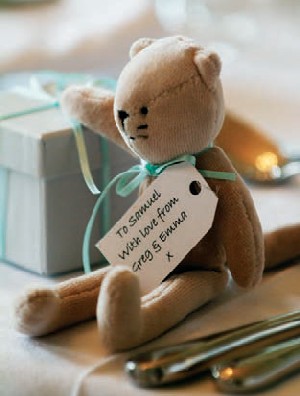
This little bear was on the chair and I decided to prop him up on the table and to turn the label over to capture the personal message. Even bears get the contre-jour treatment

I hoisted my camera high up against the wall on the top of my monopod for this time exposure
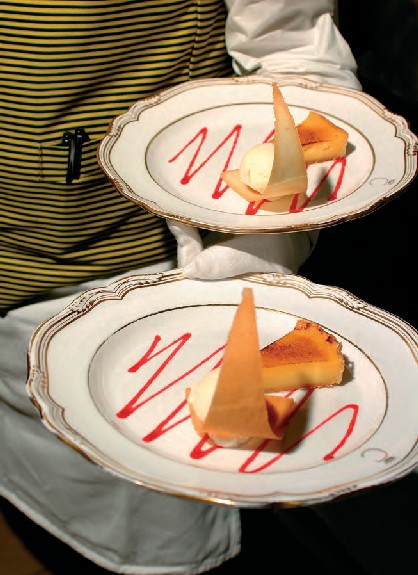
This grab shot of a passing waiter was entirely lit with off-camera flash
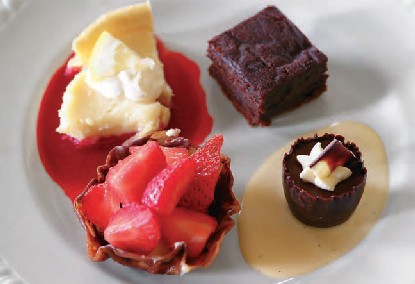
This was my dessert and I chose to hold the flash at a low angle to make some fun shadows. My dinner was my just reward
Once everyone else joins in the dancing I aim to capture a few wide shots showing the scale of the fun and a few closeups of key guests letting their hair down. These might be the last shots of the night depending upon the schedule. Dancing shots finish an album off nicely.
Occasionally, our clients put on a display of fireworks. I use a tripod to record the fireworks. First, I like to shoot a base to the picture that can be recognized. Then, I aim to get a few great aerial bursts to give Marko enough images to combine to form the final set of pictures. Meanwhile, Julie is sticking close to the bride and groom, and takes shots of them from behind looking skyward, and from the front with the other guests gathered around them.

90–96 inclusive ISO 800 f/4 at 1/60th for all the pictures
Sequences of pictures during the speeches really tell the story well. Notice the ratio of speaker to reaction shots. Once you have got a good picture of the speaker concentrate on everyone else
FAREWELL
Once that’s in the bag, we say our goodbyes and head back to the car with the rest of our gear. By this time the wedding coordinator has long gone, so we concern ourselves with the guests with whom we have struck up a rapport. Finally, we thank the bride’s parents for dinner and we are gone.
Once back at our hotel it is my task to finish downloading the remaining pictures and confirm we have all the pictures shot. I sort them by ‘time taken’ and this puts them in chronological order. Once all files are present and correct I switch off, shut down, and crash out. It can be as late as 1 am before my head hits the pillow. I sleep very well indeed knowing that we have a great set of pictures from the wedding.
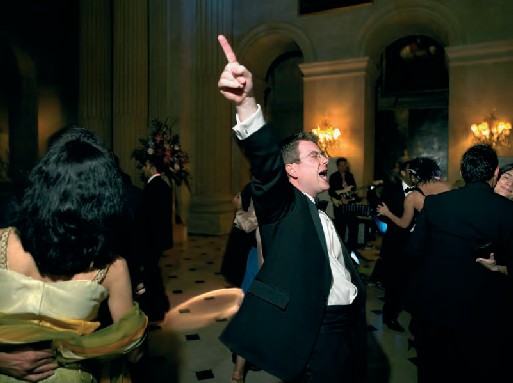
Sometimes it really is very dark indeed. I always extend the exposure time enough to get the background to record. Nothing is worse than a black hole for a background

